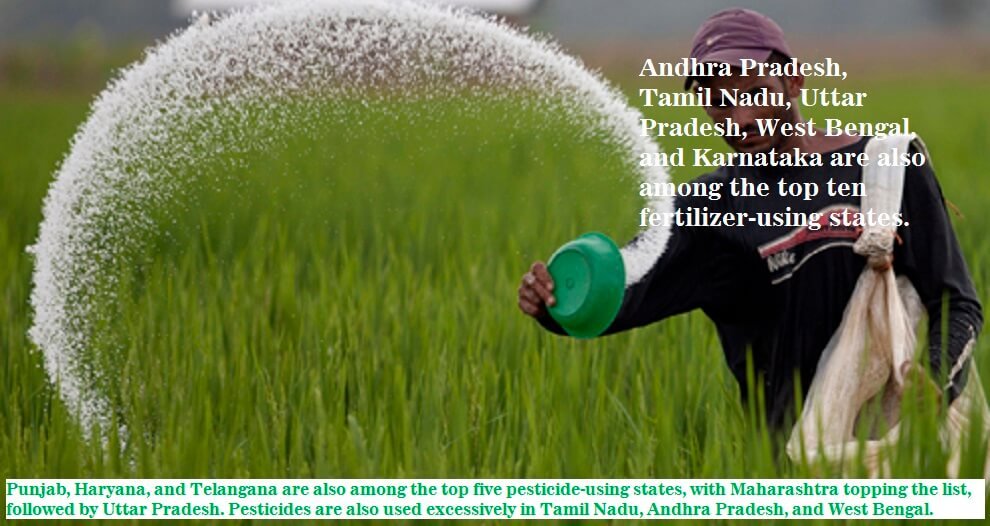Despite its small size and population in comparison to other States and UTs, Pondicherry leads the way in major fertilizer consumption (in kg/hectare) from 2015-16 to 2019-20, followed by Telangana and Punjab. Surprisingly, Bihar is co – equal with Haryana in terms of fertilizer use.
Andhra Pradesh, Tamil Nadu, Uttar Pradesh, West Bengal, and Karnataka are also among the top ten fertilizer-using states.
Punjab, Haryana, and Telangana are also among the top five pesticide-using states, with Maharashtra topping the list, followed by Uttar Pradesh. Pesticides are also used excessively in Tamil Nadu, Andhra Pradesh, and West Bengal.
Chemical fertilizer usage
As per the Ministry of Agriculture, the country’s use of chemical fertilizers in 2017-18, 2018-19, 2019-20, and 2020-21 (up to kharif 2020) has been 54.38 million tonnes (MT), 56.21 million tonnes, 59.88 million tonnes, and 33.85 million tonnes of fertilizer products (Urea, Di-Ammonium Phosphate (DAP), Murate of Potash (MOP), Complexes, and Single Super Phosphate) respectively.
Also Read: Fertiliser Ministry increased purchasing limit for subsidized fertilizers
According to the data submitted by the states and UTs to the central government, Maharashtra, Madhya Pradesh, and Kerala are among the states that use the least amount of fertilizer.
As per the National Institute of Agricultural Extension Management’s Impact Study of Soil Health Card Scheme, India consumes approximately 25.6 million tonnes of fertiliser, the majority of which is nitrogen (17 million tonnes), following by phosphorous (6 million tonnes), and then potassium (3 million tonnes) (2.5 million tonnes).
‘India spends roughly Rs. 1 lakh crore on fertilizer subsidies. The subsidy sum is estimated to be around 6,500/ha of net cropped area and around 7,000/farmer, resulting in excessive use of fertilizers, especially nitrogen, at the expense of micronutrients and manure,’ according to a report.
According to the report, as a result of the excessive and unbalanced use of fertilisers, the amount of food grain generated per kg of fertiliser applied fell from 13 kg in the year 1970s to just 4 kg by 2010.
Experts are concerned that overuse of chemical fertilisers, combined with low organic matter addition and neglect of micro and secondary nutrients, would result in multi-nutrient deficiencies and degradation of soil health, especially in intensively cultivated areas.
Influence on soil quality
Over a five-decade period, the All India Coordinated Research Project on ‘Long Term Fertilizer Experiments’ found that continuous use of nitrogenous fertiliser alone had a negative impact on soil health and crop productivity, resulting in deficiencies of other major and micro nutrients.
Also Read: Chemical colour in cardamom is suspects -Food Safety Dept
Even with recommended NPK doses and more, micro and secondary nutrient deficiencies have become yield limiting factors over the years.
Plant growth and physiological problems may be hampered by nutritional deficiency. There is also the possibility of nitrate pollution in groundwater exceeding the allowable limit of 10 mg NO3-N /L as a result of excessive/overuse of nitrogenous fertilisers, especially in light-textured soils, which could have an effect on human/animal health if it’s used for drinking.


















Add Comment